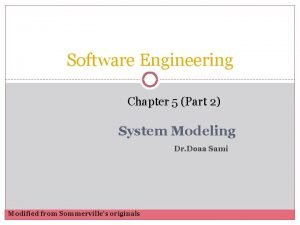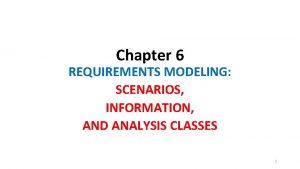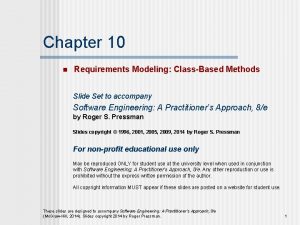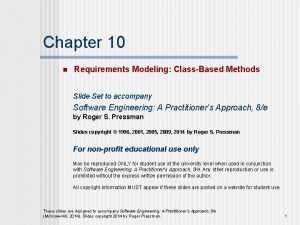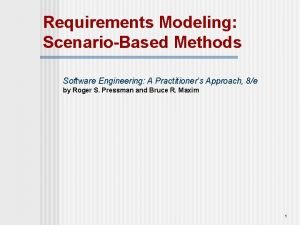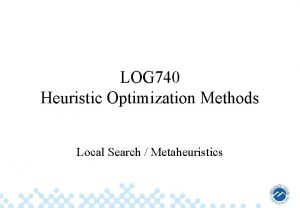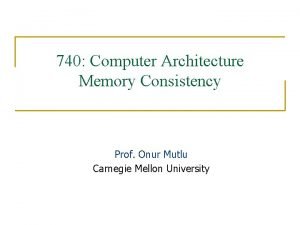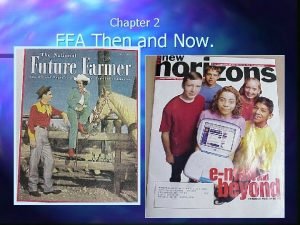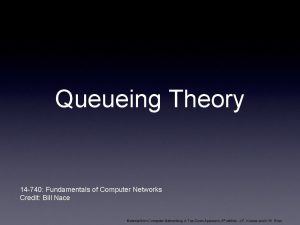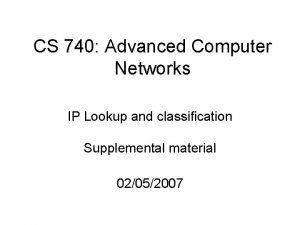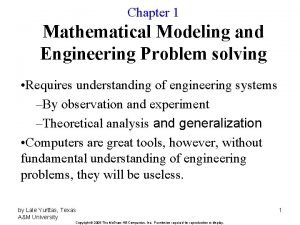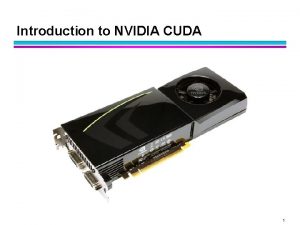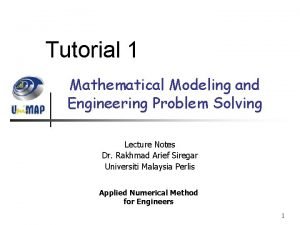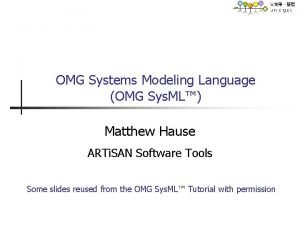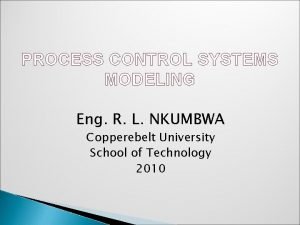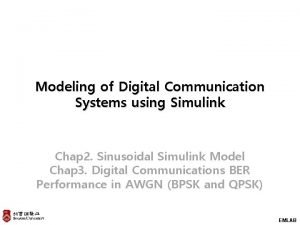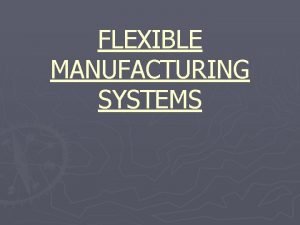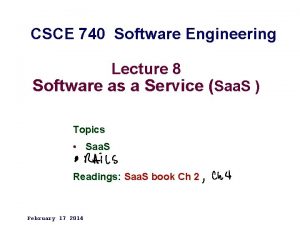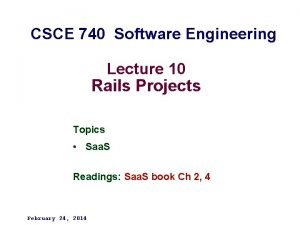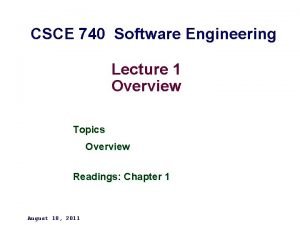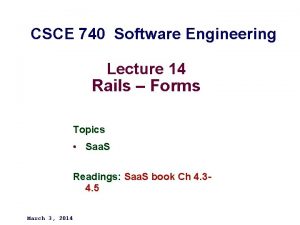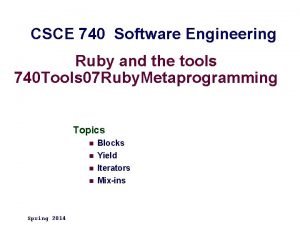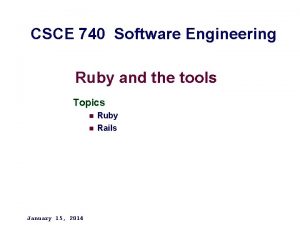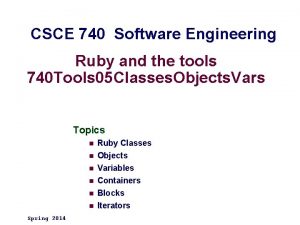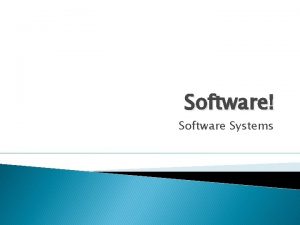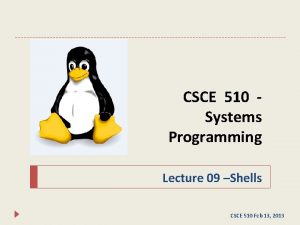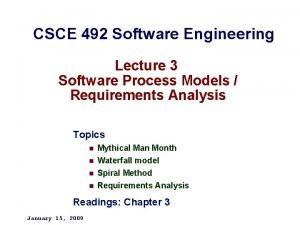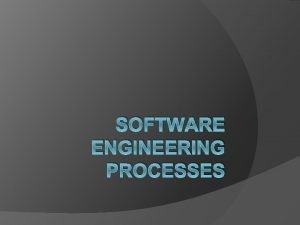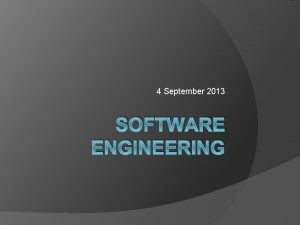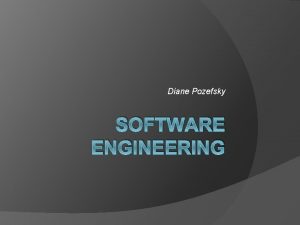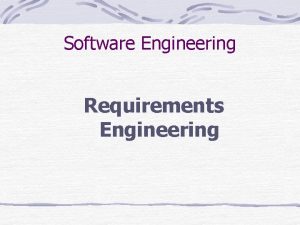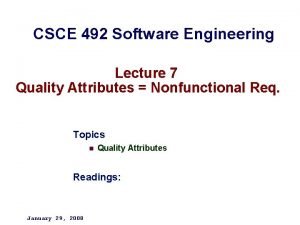CSCE 740 Software Engineering Lecture 6 Systems Modeling













































- Slides: 45

CSCE 740 Software Engineering Lecture 6 Systems Modeling Topics Overview Readings: Chapter 5 February 5, 2014

Last Time § Requirements § More Ruby Major Items on last times slides not covered § (Lec 05 slide 32 New from Chapter 5 – System Modeling § Rational Unified Process (Lec 02 slides 45 -) § Functional and non-functional requirements § The software requirements document § Requirements specification Next Time: System Modeling – 2– CSCE 740 Spring 2014

Dropbox Department Home page for Link Login with Engr(CEC) domain credentials. CSCE 740 -001 – 3– CSCE 740 Spring 2014

Topics covered Context models Interaction models Structural models Behavioral models Model-driven engineering – 4– Chapter 5 System modeling 4 CSCE 740 Spring 2014

System modeling is the process of developing abstract models of a system, with each model presenting a different view or perspective of that system. System modeling has now come to mean representing a system using some kind of graphical notation, which is now almost always based on notations in the Unified Modeling Language (UML). System modelling helps the analyst to understand the functionality of the system and models are used to communicate with customers. HW 2. 1 What is the best Free UML too? – 5– Chapter 5 System modeling 5 CSCE 740 Spring 2014

Existing and planned system models Models of new systems and existing systems are used during requirements. In a model-driven engineering process, it is possible to generate a complete or partial system implementation from the system model. – 6– Chapter 5 System modeling 6 CSCE 740 Spring 2014

System perspectives An external perspective, where you model the context or environment of the system. An interaction perspective, where you model the interactions between a system and its environment, or between the components of a system. A structural perspective, where you model the organization of a system or the structure of the data that is processed by the system. A behavioral perspective, where you model the dynamic behavior of the system and how it responds to events. – 7– Chapter 5 System modeling 7 CSCE 740 Spring 2014

UML diagram types Activity diagrams, which show the activities involved in a process or in data processing. Use case diagrams, which show the interactions between a system and its environment. Sequence diagrams, which show interactions between actors and the system and between system components. Class diagrams, which show the object classes in the system and the associations between these classes. State diagrams, which show the system reacts to internal and external events. • – 8– http: //en. wikipedia. org/wiki/A_picture_is_worth_a_thousand_words Chapter 5 System modeling 8 CSCE 740 Spring 2014

The context of the MHC-PMS http: //www. cs. st-andrews. ac. uk/~ifs/Teaching/MSc. Sys. Eng-2004/Notes/MHCPMSCase. Study. pdf – 9– Chapter 5 System modeling 9 CSCE 740 Spring 2014

Process model of involuntary detention – 10 – Chapter 5 System modeling 10 CSCE 740 Spring 2014

Use case modeling Use cases were developed originally to support requirements elicitation and now incorporated into the UML. Each use case represents a discrete task that involves external interaction with a system. Actors in a use case may be people or other systems. Represented diagrammatically to provide an overview of the use case and in a more detailed textual form. – 11 – Chapter 5 System modeling 11 CSCE 740 Spring 2014

Transfer-data use case A use case in the MHC-PMS – 12 – Chapter 5 System modeling 12 CSCE 740 Spring 2014

Tabular description of the ‘Transfer data’ use-case MHC-PMS: Transfer data – 13 – Actors Medical receptionist, patient records system (PRS) Description Data A receptionist may transfer data from the MHC-PMS to a general patient record database that is maintained by a health authority. The information transferred may either be updated personal information (address, phone number, etc. ) or a summary of the patient’s diagnosis and treatment. Patient’s personal information, treatment summary Stimulus User command issued by medical receptionist Response Confirmation that PRS has been updated Comments The receptionist must have appropriate security permissions to access the patient information and the PRS. Chapter 5 System modeling 13 CSCE 740 Spring 2014

Use cases in the MHC-PMS involving the role ‘Medical Receptionist’ – 14 – Chapter 5 System modeling 14 CSCE 740 Spring 2014

Sequence diagrams are part of the UML and are used to model the interactions between the actors and the objects within a system. A sequence diagram shows the sequence of interactions that take place during a particular use case or use case instance. The objects and actors involved are listed along the top of the diagram, with a dotted line drawn vertically from these. Interactions between objects are indicated by annotated arrows. – 15 – Chapter 5 System modeling 15 CSCE 740 Spring 2014

Sequence diagram for View patient information – 16 – Chapter 5 System modeling 16 CSCE 740 Spring 2014

Sequence diagram for Transfer Data – 17 – Chapter 5 System modeling 17 CSCE 740 Spring 2014

Structural models of software display the organization of a system in terms of the components that make up that system and their relationships. • Architectural diagrams • Class diagrams – 18 – Chapter 5 System modeling 18 CSCE 740 Spring 2014

Class diagrams are used when developing an objectoriented system model to show the classes in a system and the associations between these classes. An object class can be thought of as a general definition of one kind of system object. An association is a link between classes that indicates that there is some relationship between these classes. When you are developing models during the early stages of the software engineering process, objects represent something in the real world, such as a patient, a prescription, doctor, etc. – 19 – Chapter 5 System modeling 19 CSCE 740 Spring 2014

Classes and associations in the MHCPMS – 20 – Chapter 5 System modeling 20 CSCE 740 Spring 2014

The Consultation class – 21 – Chapter 5 System modeling 21 CSCE 740 Spring 2014

Key points A model is an abstract view of a system that ignores system details. Complementary system models can be developed to show the system’s context, interactions, structure and behaviour. Context models show a system that is being modeled is positioned in an environment with other systems and processes. Use case diagrams and sequence diagrams are used to describe the interactions between users and systems in the system being designed. Use cases describe interactions between a system and external actors; sequence diagrams add more information to these by showing interactions between system objects. Structural models show the organization and architecture of a system. Class diagrams are used to define the static structure of classes in a system and their associations. – 22 – Chapter 5 System modeling 22 CSCE 740 Spring 2014

A generalization hierarchy – 23 – Chapter 5 System modeling 23 CSCE 740 Spring 2014

A generalization hierarchy with added detail – 24 – Chapter 5 System modeling 24 CSCE 740 Spring 2014

Object class aggregation models An aggregation model shows how classes that are collections are composed of other classes. Aggregation models are similar to the part-of relationship in semantic data models. – 25 – Chapter 5 System modeling 25 CSCE 740 Spring 2014

The aggregation association – 26 – Chapter 5 System modeling 26 CSCE 740 Spring 2014

Behavioral models are models of the dynamic behavior of a system as it is executing. They show what happens or what is supposed to happen when a system responds to a stimulus from its environment. You can think of these stimuli as being of two types: n n – 27 – Data Some data arrives that has to be processed by the system. Events Some event happens that triggers system processing. Events may have associated data, although this is not always the case. Chapter 5 System modeling 27 CSCE 740 Spring 2014

Data-driven modeling Many business systems are data-processing systems that are primarily driven by data. They are controlled by the data input to the system, with relatively little external event processing. Data-driven models show the sequence of actions involved in processing input data and generating an associated output. – 28 – Chapter 5 System modeling 28 CSCE 740 Spring 2014

An activity model of the insulin pump’s operation – 29 – Chapter 5 System modeling 29 CSCE 740 Spring 2014

Order processing – 30 – Chapter 5 System modeling 30 CSCE 740 Spring 2014

Event-driven modeling Real-time systems are often event-driven, with minimal data processing. For example, a landline phone switching system responds to events such as ‘receiver off hook’ by generating a dial tone. Event-driven modeling shows how a system responds to external and internal events. It is based on the assumption that a system has a finite number of states and that events (stimuli) may cause a transition from one state to another. – 31 – Chapter 5 System modeling 31 CSCE 740 Spring 2014

State machine models These model the behaviour of the system in response to external and internal events. They show the system’s responses to stimuli so are often used for modelling real-time systems. State machine models show system states as nodes and events as arcs between these nodes. When an event occurs, the system moves from one state to another. Statecharts are an integral part of the UML and are used to represent state machine models. – 32 – Chapter 5 System modeling 32 CSCE 740 Spring 2014

State diagram of a microwave oven – 33 – Chapter 5 System modeling 33 CSCE 740 Spring 2014

States and stimuli for the microwave oven (a) State Description Waiting The oven is waiting for input. The display shows the current time. Half power The oven power is set to 300 watts. The display shows ‘Half power’. Full power The oven power is set to 600 watts. The display shows ‘Full power’. Set time The cooking time is set to the user’s input value. The display shows the cooking time selected and is updated as the time is set. Disabled Oven operation is disabled for safety. Interior oven light is on. Display shows ‘Not ready’. Enabled Oven operation is enabled. Interior oven light is off. Display shows ‘Ready to cook’. Operation Oven in operation. Interior oven light is on. Display shows the timer countdown. On completion of cooking, the buzzer is sounded for five seconds. Oven light is on. Display shows ‘Cooking complete’ while buzzer is sounding. – 34 – Chapter 5 System modeling 34 CSCE 740 Spring 2014

States and stimuli for the microwave oven (b) – 35 – Stimulus Description Half power The user has pressed the half-power button. Full power The user has pressed the full-power button. Timer The user has pressed one of the timer buttons. Number The user has pressed a numeric key. Door open The oven door switch is not closed. Door closed The oven door switch is closed. Start The user has pressed the Start button. Cancel The user has pressed the Cancel button. Chapter 5 System modeling 35 CSCE 740 Spring 2014

Microwave oven operation – 36 – Chapter 5 System modeling 36 CSCE 740 Spring 2014

Model-driven engineering (MDE) is an approach to software development where models rather than programs are the principal outputs of the development process. The programs that execute on a hardware/software platform are then generated automatically from the models. Proponents of MDE argue that this raises the level of abstraction in software engineering so that engineers no longer have to be concerned with programming language details or the specifics of execution platforms. – 37 – Chapter 5 System modeling 37 CSCE 740 Spring 2014

Usage of model-driven engineering Model-driven engineering is still at an early stage of development, and it is unclear whether or not it will have a significant effect on software engineering practice. Pros n n Allows systems to be considered at higher levels of abstraction Generating code automatically means that it is cheaper to adapt systems to new platforms. Cons n n – 38 – Models for abstraction and not necessarily right for implementation. Savings from generating code may be outweighed by the costs of developing translators for new platforms. Chapter 5 System modeling 38 CSCE 740 Spring 2014

Model driven architecture Model-driven architecture (MDA) was the precursor of more general model-driven engineering MDA is a model-focused approach to software design and implementation that uses a subset of UML models to describe a system. Models at different levels of abstraction are created. From a high-level, platform independent model, it is possible, in principle, to generate a working program without manual intervention. – 39 – Chapter 5 System modeling 39 CSCE 740 Spring 2014

Types of model A computation independent model (CIM) n These model the important domain abstractions used in a system. CIMs are sometimes called domain models. A platform independent model (PIM) n These model the operation of the system without reference to its implementation. The PIM is usually described using UML models that show the static system structure and how it responds to external and internal events. Platform specific models (PSM) n – 40 – These are transformations of the platform-independent model with a separate PSM for each application platform. In principle, there may be layers of PSM, with each layer adding some platform-specific detail. Chapter 5 System modeling 40 CSCE 740 Spring 2014

Agile methods and MDA The developers of MDA claim that it is intended to support an iterative approach to development and so can be used within agile methods. The notion of extensive up-front modeling contradicts the fundamental ideas in the agile manifesto and I suspect that few agile developers feel comfortable with model-driven engineering. If transformations can be completely automated and a complete program generated from a PIM, then, in principle, MDA could be used in an agile development process as no separate coding would be required. – 41 – Chapter 5 System modeling 41 CSCE 740 Spring 2014

Executable UML The fundamental notion behind model-driven engineering is that completely automated transformation of models to code should be possible. This is possible using a subset of UML 2, called Executable UML or x. UML. – 42 – Chapter 5 System modeling 42 CSCE 740 Spring 2014

Features of executable UML To create an executable subset of UML, the number of model types has therefore been dramatically reduced to these 3 key types: n n n Domain models that identify the principal concerns in a system. They are defined using UML class diagrams and include objects, attributes and associations. Class models in which classes are defined, along with their attributes and operations. State models in which a state diagram is associated with each class and is used to describe the life cycle of the class. The dynamic behaviour of the system may be specified declaratively using the object constraint language (OCL), or may be expressed using UML’s action language. – 43 – Chapter 5 System modeling 43 CSCE 740 Spring 2014

Key points Behavioral models are used to describe the dynamic behavior of an executing system. This behavior can be modeled from the perspective of the data processed by the system, or by the events that stimulate responses from a system. Activity diagrams may be used to model the processing of data, where each activity represents one process step. State diagrams are used to model a system’s behavior in response to internal or external events. Model-driven engineering is an approach to software development in which a system is represented as a set of models that can be automatically transformed to executable code. – 44 – Chapter 5 System modeling 44 CSCE 740 Spring 2014

HW 2 – Due Tuesday September 18 1. HW 2. 1 What is the best Free UML too? 2. Read MHC-PMS document – paragraph summary emphasizing diagrams n http: //www. cs. st-andrews. ac. uk/~ifs/Teaching/MSc. Sys. Eng-2004/Notes/MHCPMSCase. Study. pdf 3. Ruby program to read web page and display links. n Google – ruby url reader open-uri (2005) l n – 45 – http: //stdlib. rubyonrails. org/libdoc/open-uri/rdoc/index. html Made any progress since then? REXML maybe? URI maybe? CSCE 740 Spring 2014
 Principles of complex systems for systems engineering
Principles of complex systems for systems engineering Engineering elegant systems: theory of systems engineering
Engineering elegant systems: theory of systems engineering Context models in software engineering
Context models in software engineering Generalization in software engineering
Generalization in software engineering Scenario based modeling
Scenario based modeling What is class based modeling in software engineering
What is class based modeling in software engineering Class based modeling in software engineering
Class based modeling in software engineering Scenario based modeling in software engineering
Scenario based modeling in software engineering Software engineering lecture notes
Software engineering lecture notes Modeling and role modeling theory
Modeling and role modeling theory Dimensional modeling vs relational modeling
Dimensional modeling vs relational modeling Asc 740
Asc 740 Sfas 109
Sfas 109 Asc 740-30-25-9
Asc 740-30-25-9 740
740 Gabriel deloitte
Gabriel deloitte 740
740 Who wrote the ffa creed? when was it adopted?
Who wrote the ffa creed? when was it adopted? 14-740
14-740 F 740
F 740 Dell 740r
Dell 740r Cs 740
Cs 740 01:640:244 lecture notes - lecture 15: plat, idah, farad
01:640:244 lecture notes - lecture 15: plat, idah, farad What is system in software engineering
What is system in software engineering Forward engineering and reverse engineering
Forward engineering and reverse engineering Software maintenance in software engineering ppt
Software maintenance in software engineering ppt Frank maurer
Frank maurer Metrics computer science
Metrics computer science Types of software crisis
Types of software crisis Software metrics example
Software metrics example Real time software design in software engineering
Real time software design in software engineering Software design fundamentals in software engineering
Software design fundamentals in software engineering Mathematical modeling and engineering problem solving
Mathematical modeling and engineering problem solving Computational engineering and physical modeling
Computational engineering and physical modeling Mathematical modeling and engineering problem solving
Mathematical modeling and engineering problem solving Omg systems modeling language
Omg systems modeling language Complex impedances
Complex impedances Control systems modeling
Control systems modeling Modeling of digital communication systems using simulink
Modeling of digital communication systems using simulink Modeling of digital communication systems using simulink
Modeling of digital communication systems using simulink Manufacturing systems modeling and analysis
Manufacturing systems modeling and analysis Financial engineering notes
Financial engineering notes Foundation engineering lecture notes
Foundation engineering lecture notes Professional ethics in engineering notes
Professional ethics in engineering notes Operating system lecture notes
Operating system lecture notes Lecture sound systems
Lecture sound systems



